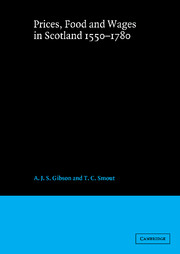Book contents
- Front Matter
- Contents
- Figures
- Tables
- Acknowledgements
- Abbreviations
- A note on Scottish and English money
- Map of Scottish counties and principal burghs
- 1 Introduction
- 2 The system of burgh price regulation
- 3 The system of county fiars
- 4 Press reports of monthly market prices
- 5 Trends and fluctuations in grain-price movements
- 6 The price of animals and animal products
- 7 Food
- 8 Wages in money and kind
- 9 Real wages
- Appendix I Scottish weights and measures, 1580–1780
- Appendix II Accessing the data
- Bibliography
- Persons index
- Place index
- Subject index
Appendix I - Scottish weights and measures, 1580–1780
Published online by Cambridge University Press: 22 September 2009
- Front Matter
- Contents
- Figures
- Tables
- Acknowledgements
- Abbreviations
- A note on Scottish and English money
- Map of Scottish counties and principal burghs
- 1 Introduction
- 2 The system of burgh price regulation
- 3 The system of county fiars
- 4 Press reports of monthly market prices
- 5 Trends and fluctuations in grain-price movements
- 6 The price of animals and animal products
- 7 Food
- 8 Wages in money and kind
- 9 Real wages
- Appendix I Scottish weights and measures, 1580–1780
- Appendix II Accessing the data
- Bibliography
- Persons index
- Place index
- Subject index
Summary
Although the early modern period was marked by increasing legislative concern with the standardisation of weights and measures, this was a process which made only gradual headway prior to the nineteenth century. With a plethora of local weights and measures standing alongside the still evolving national standards, identifying which particular system of weight or measurement was in use in various contexts has posed one of the most intractable evidential problems we have had to face. Zupko's paper on weights and measures in Scotland makes clear how complex the situation could be. In Forfarshire, to take one example, butcher meat was sold by Scottish troy weight, but butter and cheese according to a tron pound which varied in size across the county from 22 oz. avoirdupois in Dundee, Arbroath and Cupar to 27 oz. avoirdupois in Kirriemuir. In spite of Zupko's work and the invaluable evidence to be found in John Swinton's late eighteenth-century plea for standardisation, a full understanding of the regional use of customary systems remains elusive.
Interpreting the price series in the foregoing tables is, to some extent confused rather than clarified by the process of standardisation that was underway. Thus whilst many of the longer price series, in particular the fiars, were probably initially set down in terms of local customary measures, in time the national standards came to be adopted.
- Type
- Chapter
- Information
- Prices, Food and Wages in Scotland, 1550–1780 , pp. 365 - 375Publisher: Cambridge University PressPrint publication year: 1994
- 1
- Cited by



